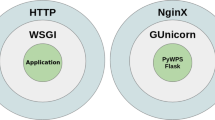Abstract
This part, PART IIF [6], concludes the document “HIGH-SPEED TOOLS FOR GLOBAL INFORMATION MANAGEMENT. II. Specifications and Uses of the Transparent Query Language (TQL)” [1–6]. It describes novel applications of TQL, the key data structures, and contains a dictionary of Transparent Query Language terms. PART IIF references PART IIA [1], PART IIB [2], PART IIC [3], PART IID [4], and PART IIE [5] and contains Conclusions and Acknowledgements.
Similar content being viewed by others
References
Paul A. D. de Maine, Kenneth D. Bradley, Stephen M. Jodis and Margaret M. de Maine, “High-speed tools for global information management. II. Specification and uses of the transparent query language (TQL). Part IIA. Introduction.” J. Systems Integration 8, pp. 319–341, 1998.
Paul A. D. de Maine, Kenneth D. Bradley, Stephen M. Jodis and Margaret M. de Maine, “High-speed tools for global information management. II. Specification and uses of the transparent query language (TQL). Part IIB. Properties of transparent query language items.” J. Systems Integration 8, pp. 343–358, 1998.
Paul A. D. de Maine, Kenneth D. Bradley, Stephen M. Jodis and Margaret M. de Maine, “High-speed tools for global information management. II. Specification and uses of the transparent query language (TQL). Part IIC. Security system, registry numbers, transparent query language commands.” J. Systems Integration 8, pp. 359–377, 1998.
Paul A. D. de Maine, Kenneth D. Bradley, Stephen M. Jodis and Margaret M. de Maine, “High-speed tools for global information management. II. Specification and uses of the transparent query language (TQL). Part IID. Manipulation of information representations.” J. Systems Integration 9, pp. 5–28, 1999.
Paul A. D. de Maine, Kenneth D. Bradley, Stephen M. Jodis and Margaret M. de Maine, “High-speed tools for global information management. II. Specification and uses of the transparent query language (TQL). Part IIE. Transparent use of the transparent query language.” J. Systems Integration 9, pp. 29–53, 1999.
Paul A. D. de Maine, Kenneth D. Bradley, Stephen M. Jodis and Margaret M. de Maine, “High-speed tools for global information management. II. Specification and uses of the transparent query language (TQL). Part IIF. Additional uses of the transparent query language, data structures, concise definitions, conclusions and acknowledgments.” J. Systems Integration 9, pp. 55–71, 1999.
P. A. D. de Maine and K. D. Bradley, “High-speed tools for global information management I. Information processing and retrieval.” J. of Systems Integration 6, pp. 217–240, 1996.
P. A. D. de Maine and B. A. Marron, “The SOLID system I. A method for organizing and searching files,” in G. Schecter (ed.) Information Retrieval: A Critical View, G. Thompson Book Co.: Washington, D.C., pp. 243–282, 1967.
Ping Xia, “Normalization in the solid system,” Computer Science and Engineering Department, Auburn University, Auburn, AL 36849, Report no. 23 of the series: Automatic Systems for the Physical Sciences, CSE-92-01, Computer Science and Engineering Dept., Auburn University, Auburn, AL, 36849. 128 pages, April 1992.
Paul A. D. de Maine and Ping Xia, “High-speed manipulation of information representations. I. Normalization and mobile canonicalization.” Computers Chem. 22, pp. 321–330, 1998.
Paul A. D. de Maine, “High-speed manipulation of information representation. II. Fragment (Markush) searches.” Computers Chem. 22, pp. 523–538, 1998.
Paul A. D. de Maine, “High-speed manipulation of information representation. III. Formulae with multiple rings.” Computers Chem. (in preparation).
Paul A. D. de Maine, “High-speed searches for fragments in the national compound registry,” in Z. S. Hippe and I. K. Ugi (eds.) MultiComponent Reactions & Combinatorial Chemistry, Proceedings of the German-Polish Workshop, University of Technology, Rzeszow, Poland, Sept. 28-30, 1997, pp. 61–83, 1998.
Paul A. D. de Maine, “High-speed management of the National Compound Registry.” J. Chem. Inf. & Comp. Sc. 14, pp. 529–543, 1998.
Paul A. D. de Maine, K. D. Bradley, W. H. Carlisle, and W. B. Dress, “Integrated systems I. Design principles.” J. of Systems Integration 5, pp. 187–200, 1995.
Paul A. D. de Maine, “Design principles for discipline independent rule based systems.” Foundations of Computer and Decision Sciences 19, pp. 116–125, 1994.
Paul A. D. de Maine, S. Leong and C. G. Davis, “A transportable programming language (TPL) system I. Overview.” Int. J. Comp. and Information Sciences 14, pp. 161–182, 1985.
S. Leong, S. Jodis, K. Sullivan, O. Jiang and P. A. D. de Maine, “A transportable programming language (TPL) system II. The bifunctional compiler system.” IEEE Trans. on Software Engineering 16, pp. 639–646, 1990.
G. Salton. Automatic Text Processing, The Transformation Analysis, and Retrieval of Information by Computer. Addison-Wesley: Reading, MA, 1989.
G. Salton and M. J. McGill, Introduction to Modern Information Retrieval. McGraw-Hill, Inc., pp. 118–145, 1983.
D. J. Hillman, “Mathematical theories of relevance with respect to the problems of indexing. Report no. 2: An algorithm for document characterization.” Report to the National Science foundation on grant no. GN-177, 12 March 1965.
D. J. Hillman, “Document retrieval theory, relevance, and the methodology of evaluation. Report no. 1: Characterization and Connectivity.” Report to the National Science Foundation on grant no. GN-451, 24 May 1966.
P. A. D. de Maine and K. G. Price, “Integrated systems II. Multi-tier interfaces for integrating heterogeneous families of systems.” J. of System Integration 5, pp. 201–217, 1995.
Kenneth D. Bradley and P. A. D. de Maine, “High-speed tools for global information management III. Integrating rule based systems to perform command and control functions.” J. Systems Integration (to be submitted).
Qianhong Liu and Peter A. Ng, “A query generalizer for providing cooperative responses in and office document system.” Data and Knowledge Eng. 27(2), pp. 177–205, 1998.
Zhijian Zhu, Qianhong Liu, James A. McHugh, and Peter A. Ng, “A predicate-driven filing system.” J. Systems Integration 6, pp. 241–259, 1996.
P. A. D. de Maine, Peter A.-B. Ng, and M. M. de Maine, “Perception and identification of entities in different environments.” Computer Science and Engineering Department, Auburn University, Auburn, AL 36849, Report no. 11 of the series: Automatic Systems for the Physical Sciences, 35 pages, March 1987.
D. M. Head, “The SOLID-user interface.” Auburn University, M.S. Thesis, 1987.
P. A. D. de Maine and D. M. Head, “Problems of hardware and software in chemical information systems.” Anal. Chim. Acta 210, pp. 73–88, 1988.
J. Dugundji and I. Ugi, “An algebraic model of constitutional chemistry as a basis for chemical computer programs.” Topics in Curr. Chem. 39, pp. 19–64, 1973.
I. K. Ugi, A Qualitative Global Mathematical View of Chemistry-James Dugundji's Contribution to Computer Assistance in Chemistry. Dr. Alfred Huthig Verlag GmbH: Heidelberg, pp. 345–366, 1989.
I. Ugi, B. Gruber, N. Stein, and A. Demharter. “Set-valued maps as a mathematical basis of computer assistance in stereochemistry.” J. Chem. Inf. & Comp. Sci. 30, pp. 485–489, 1990.
J. Bauer, E. Fontain, and I. Ugi, “IGOR and RAIN-The first mathematically based multipurpose problemsolving computer programs for chemistry and their use ::::” Comm. in Math. Chem. (MATCH) 27, pp. 31–48, 1992.
I. Ugi, J. Bauer, C. Blomberger, J. Brandt, A. Dietz, E. Fontain, B. Gruber, A. v. Scholley-Pjab, A. Senff, and N. Stein, “Models, concepts, theories & formal languages in chemistry and their use as a basis for computer assistance in chemistry,” J. Chem. Inf. & Comp. Sci. 34, pp. 3–16, 1993.
Author information
Authors and Affiliations
Rights and permissions
About this article
Cite this article
Maine, P.A.D.d., Bradley, K.D., Jodis, S.M. et al. High-Speed Tools for Global Information Management.II. Specifications and Uses of the Transparent Query Language (TQL) Part IIF. Additional Uses of TQL, Data Structures, Concise Definitions, Conclusions and Acknowledgments. Journal of Systems Integration 9, 55–71 (1999). https://doi.org/10.1023/A:1008402503920
Issue Date:
DOI: https://doi.org/10.1023/A:1008402503920




